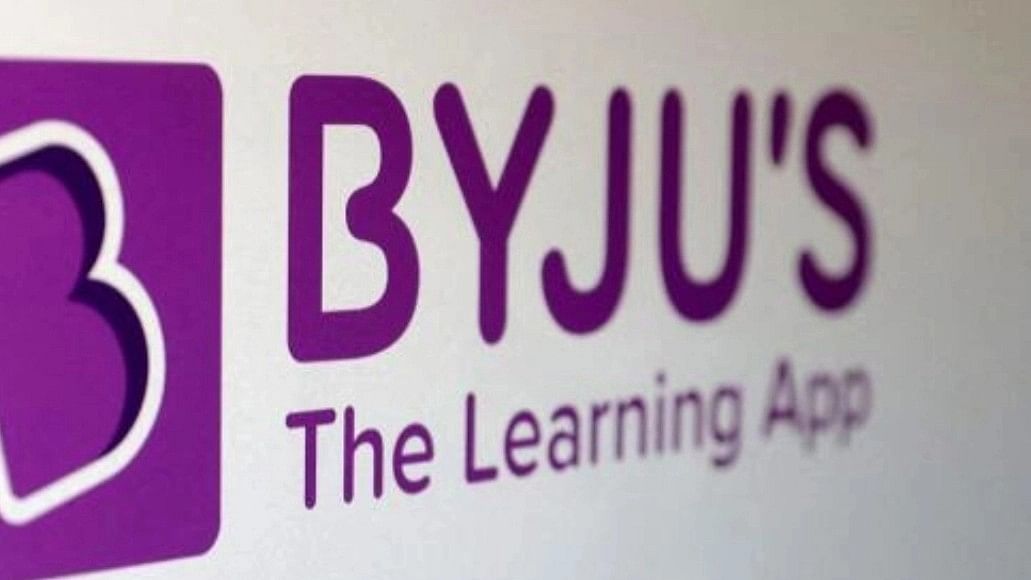
Byju's logo.
Credit: Reuters Photo
Bengaluru: Brandished as the most successful ed-tech startup of the country, Byju’s came tagged with a rags-to-riches story of its founder Byju Raveendran's rise from running a humble coaching institute to floating a pioneering online entity which soon stamped its leadership with a pan-India and multi-disciplinary presence. The platform rode the remote education tide during the pandemic and the ensuing lockdowns, with great aplomb. At its height in 2022, the company was valued at $22 billion, an outlier even for India’s growing list of startup unicorns. But today, just two years later the company is fighting to stay afloat after suffering a 99% valuation cut, with its founder grappling to raise a mere $200 million. In this edition of DH Deciphers, Anjali Jain decodes what went wrong with India’s favourite startup unicorn, and what lies ahead.
How did the most valued Indian unicorn begin its downfall?
Byju’s pioneered India’s now crowded edtech market by offering a tech-based alternative to supplement classroom learning, which became especially popular during the pandemic induced school closures. Even before that, Byju’s had employed a relentless sales team that reportedly targeted single mothers and economically disadvantaged parents, even providing education loans.
However, once students returned to school, online education, especially the content-heavy kind that Byju’s offered, fell out of favour. The company’s failure to file financial reports, coupled with financial mismanagement (that included a global acquisition spree and an aggressive marketing strategy that involved multi-million (dollar?) deals like sponsoring the Indian cricket team and employing Lionel Messi as a brand ambassador eating into its balance sheet) eroded its corporate credibility. Its loans and acquisitions soon came back to bite it.
What are the present woes of the company?
At the heart of Byju’s troubles is a $1.2 billion term loan B that it took in 2022 from foreign lenders including Redwood Capital Management and Silver Point Capital. After it failed to pay interest of $40 million in June last year, the company sued the lenders in a US Court and halted all payments. After multiple failed attempts to restructure the loan, the lenders have forced the US subsidiary Byju’s - Alpha - to file for bankruptcy, and initiated similar proceedings in Bengaluru’s National Company Law Tribunal.
Two other insolvency proceedings have been filed against Byju’s - one by vendors for non-payment of dues and another by the Board of Control for Cricket in India (BCCI) for failure to keep up with the Rs 158-crore sponsorship. It is also under investigation by the Enforcement Directorate for violating FEMA rules, and by the Ministry of Corporate Affairs for delay in filing financial statements.
Over the past year, some its biggest venture capital backers, including Prosus, BlackRock and Peak XV, have slashed the company’s valuation, exited its board over financial irregularities, and more recently, tried to oust Raveendran from the company’s leadership.
How has the company tried to address its financial crisis?
In an attempt to manage cash burn, the company has laid off thousands of employees since the beginning of 2023. It also let go of multiple office spaces it had leased in Bengaluru, and shifted remaining employees to its few operational locations. Employees have complained of constant salary delays, and Raveendran has pumped in nearly $1 billion from his own pockets and sold one of his properties, to keep the company running.
The company embarked on a restructuring exercise late last year under its new chief executive officer Arjun Mohan, which included the ouster of some leadership positions, additional layoffs and simplified operating structures to achieve operational profitability. The company last month reported financials for FY22 which showed a 2.2 times growth in operating revenue and a 80.65% increase in its losses, which the company attributed to poor performance from acquired subsidiaries like Whitehat Jr and OSMO while claiming to be on the path to profitability in the current financial year.
How is it trying to improve its balance sheet?
The company is looking to offload Epic and Great Learning in a combined asset sale worth $1 billion, that few seem to be interested in. This is after bad optics dashed its efforts to raise fresh funds.
Now, the company is looking to raise $200 million from existing investors through a fresh rights issue at a post-money valuation of around $225 million. Raveendran last week claimed that it was already oversubscribed within a week of opening. Byju’s is also expected to make its brick and mortar test preparatory arm and crown jewel Aakash Institute public this year after acquiring it for $950 million in 2021. The subsidiary may also receive fresh funding from Manipal Group Head Ranjan Pai, who already owns a majority stake.